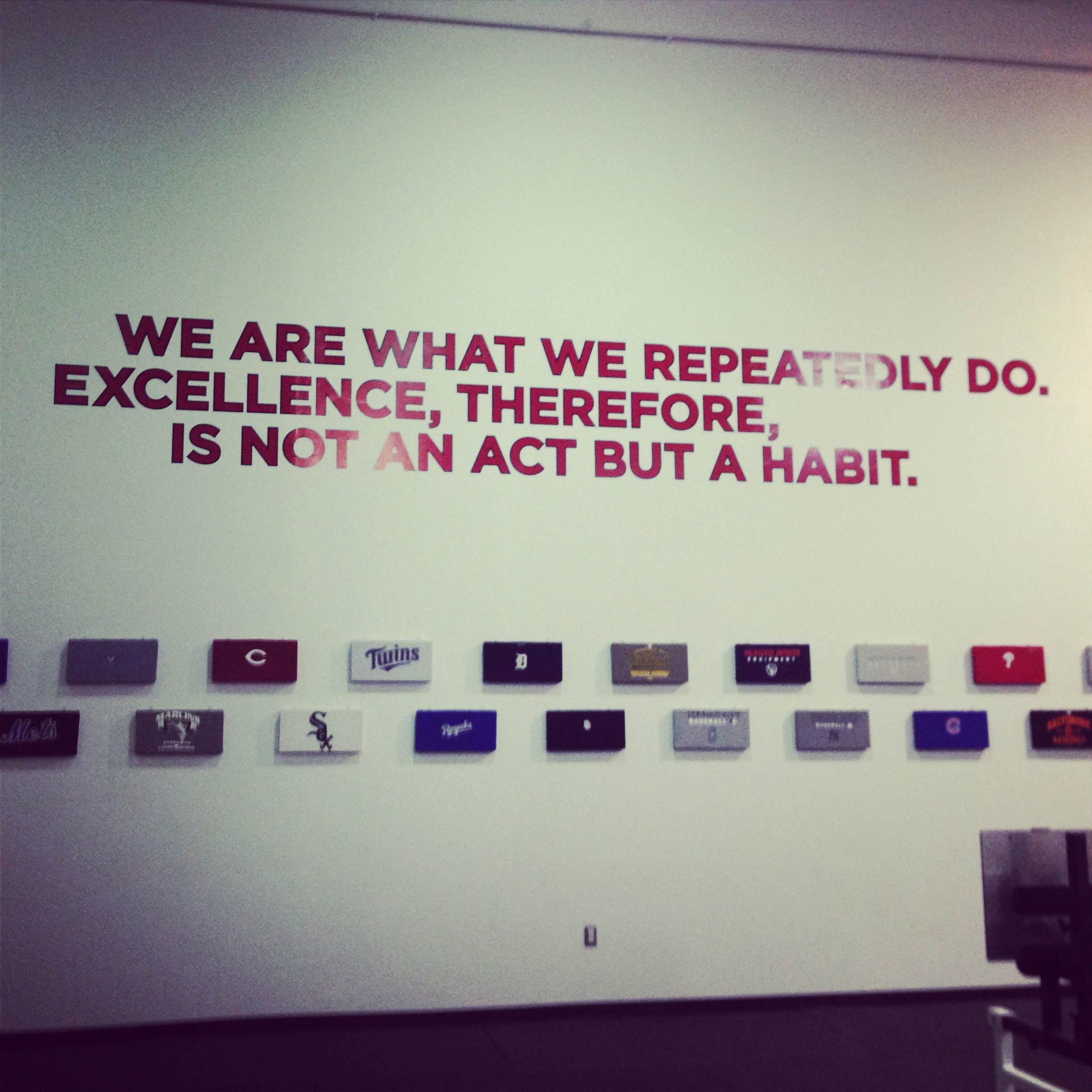I had the pleasure of attending the Boston Sports Medicine Performance Group (BSMPG) annual conference this past weekend at Northeastern University.
First off: props to Art Horne for pulling off – yet again – another spectacular job organizing and hosting the event. You, sir, deserve this:
https://www.youtube.com/watch?v=TAryFIuRxmQ
Second off: this is easily one of the more “high-level” events of the year on the fitness calendar, and I can’t speak highly enough to the caliber and quality of not only the speakers, but the attendees as well.
Ever have that feeling you’re the dumbest person in the room? Well that was me this past Friday with guys like Bill Hartman, Charlie Weingroff, Pat Davidson, Eric Oetter, Dr. James Anderson, and the pencil sharpener located at the front of the room all under one roof.
If you’ve never heard of the event, now you have…and I’d highly encourage you to try to make the trip to Boston next Spring.
If you have heard of the event, and you’ve never made the trip, to you I say……..
Get it done next year.
You won’t be disappointed.
Okay, so, lets talk about stress.
Why?
Well, for starters it’s something that affects all of us in some form or another. And secondly, one of the keynote speakers this past weekend was the one and only Dr. Robert Sapolsky, author of Why Zebras Don’t Get Ulcers.
He’s one of the world’s foremost experts on stress (he wrote a book about it, duh.), and someone who’s done more research on the topic than pretty much everyone, ever.
And he has an epic beard.
Which means we should listen to him.
The good doc spoke for around 90 minutes, but it felt like it was ten. It was all fascinating.
He discussed stress and how we as humans (more specifically those of us who have been around for the last 100 or so years) have changed how we react to (both physiologically and psychologically) and cope with stress.
You see, we don’t worry so much about infectious diseases in the “modern world” today. Diseases like dysentery, leprosy, and to a much smaller degree, influenza (flu)1 used to be much more of a problem back in the day.
Omitting the looney tune anti-vaxxers in the crowd, we’ve also made diseases such as polio, measles, and smallpox all but a passing memory.
Today, however, while they still exist and certainly shouldn’t be taken lightly, it’s not infectious diseases that are the leading cause(s) of death. Rather, as Dr. Sapolsky noted, it’s diseases which take their time to slowly deteriorate our bodies over the course of decades.
Heart disease, diabetes, marriage, etc…..
“Why is it when we feel someone doesn’t love us, or we feel sad or angry, we reach for the M&Ms?
If we could figure this out, we’d cure half the cases of diabetes.”
– Dr. Sapolsky
Lets begin by defining what stress is and what a stressor is.
Stress: adaptation your body mobilizes to re-establish homeostasis in the system. I’m paraphrasing here but, “hormones are released and [stuff] happens.”
Stressors: anything in the outside world that affects homeostatic balance.
For a zebra this can be being chased by a lion. For humans this can refer to tax season or your S.O. wanting to sit down and “talk about feelings.”
To expound a bit further Dr. Sapolsky states:
“For a cognitively complex species (like humans and other primates), stressor is also the ANTICIPATION that a a real physical challenge is about to happen. If there really is not the threat of a physical stressor coming, then you are setting yourself up for increased risk of stress-related disease.
Is stress always bad? No – if a stressor isn’t too extreme, is only transient, and occurs in what overall feels like a benevolent environment, it’s great, we love it – that’s what play and stimulation are.”
To simplify things into Dr. Sapolsky’s “umbrella theme”:
As humans we can turn on the same stress response as a zebra getting chased by a lion, but we tend to do so from a purely psychological standpoint, and we have a hard time shutting it off.
Increase your blood pressure for 30 seconds to avoid being eaten by a lion = save your life. (And, dude, you just outran a lion. That’s baller.)
Increase your blood pressure for an extended amount of time (for whatever reason) = heart disease.
In other words: we’re being chased by the stress of a 30-year mortgage or rush hour traffic or being forced to watch Downton Abbey. It’s all the same.
And it’s killing us. Literally.
Some Other Factoids on the Stress Response
1. We often see a suppression of digestion with elevated stress levels. Short term example = dry mouth before public speaking. Also, “fat loss” isn’t quite as much of a priority when a black bear is starring you down and licking its chops.
All non-vital systems are shut down.
Interesting to note, and something that’s often misinterpreted is that stress does NOT create ulcers.
Bacteria – specifically Helicobacter pylori (H. pylori) – are the main culprit. But it’s our inability for our stomach to repair itself (due to stress) which is the key.
2. Chronic stress leads to myopathy (muscle loss), lethargy, and inefficient use of energy.
Interesting Fact: having a Type A Personality (characterized by impatience, hostility, low self-esteem, among others) places someone at a higher risk of developing heart disease than smoking.
Dr. Sapolsky referred to a concept he titled TOXIC HOSTILITY which I thought was spot on and a brilliant way of explaining things.
Here in Boston I see it every day. A gleaming example was yesterday while Lisa and I were walking across the parking lot from our car to the entrance of Whole Foods.
Out of nowhere this guy started blaring on his car horn because someone had the audacity to back out of their spot and hold him up for maybe five seconds.
I mean, really?
Apparently he was that important and in that much of a rush that he had to do something about it. Which was be an asshole.
I remember when I was in London last Fall I noticed virtually no one honked their horn.
Sure it happened, on occasion…but when I brought it up to some of the attendees at the workshop I was doing they noted honking the horn was kind of frowned upon over there.
Londoners just didn’t let trivial shit affect them.
This is in stark contrast to people I know or clients I’ve had who would straight up want to punch a baby seal in the face if they didn’t perform one rep correctly during their set of squats.
Long story short: is it any wonder we have some people who drop dead of a heart attack at 45?
3. We all know exercise is “good” stress, right?
But an insane amount of exercise doesn’t lead to an insane amount of benefits.
4. Long-term, chronic stress can lead to a decrease in libido as well as act as a precursor to erectile dysfunction.
How can we tell if it’s an “organic” issue or a psychological issue?
Easy. Attach this thingamajig/sensor to the penis which, once someone hits REM sleep, will send a signal via GPS to a satellite (<- may or may not be true) and let you know if you get an erection.
In all seriousness, this is true. Once he hits REM sleep the male will elicit an erection. BOM CHICKA BOM BOM.
If he’s able to do so we know it’s NOT an organic issue, but a psychological one.
5. Stress DOES NOT lead to an increase in cancer.
Dr. Sapolsky noted that there are any number of quacks (< – his words, not mine) making a fortune on their stress reducing (“cancer reducing”) treatments.
He gives everyone permission to scissor-kick anyone in the groin if they claim stress causes cancer.
Stress Management & Coping With Stress
So how can we manage stress?
It’s all about REFRAMING OUR STRESS EXPERIENCE.
Each individual is going to find (or at least should try to find) his or her’s most ideal way of coping with stress.
Dr. Sapolsky referenced a famous study done with rats where one rat was giving a shock every so often. Not surprisingly said rat developed an ulcer.
Another rat was given the same shock, but this time there was a second rat placed inside the cage. The rat given the shock could go and take out its frustration on the second rat. There was a MUCH reduced incidence of developing an ulcer.
A third rat was given the same shock, but was given a piece of wood to gnaw on (given a hobby).
A fourth rat was given the same shock, but was given a lever to press which would greatly reduce the frequency of said shock (given a sense of control).
A fifth rat was given the same shock, but had several other “rat friends” around to groom it and to act as a social support.
In all scenarios the rate of developing an ulcer was VASTLY reduced.
Why?
The rats were given an outlet of some sort, or social support. All of which led to less psychological stress.
Relaying this information to homo sapiens, stress management does work….but there are several caveats.
1. You can’t reserve it for the weekend only. You have to make a concerted effort to implement whatever strategies you pick on a daily timeline.
2. You have to choose something you actually enjoy doing.
Meditation, lifting weights, yoga, running, gardening, reading scripture to orphaned kittens, ALL work as a mode of stress management.
But if it’s an activity you don’t gain any pleasure from, it won’t work.
3. NEVER listen to anyone who states they have scientific research to back their claims or that their brand of stress management is scientifically proven to be better.
It’s BS, and makes Dr. Sapolsky very angry. Not Hulk angry, but close.

 I felt this was an excellent perspective given by Mike. When working with beginner (and even many intermediate) lifters, and those not remotely interested in deadlifting a bulldozer, advanced periodization programs and techniques probably aren’t as necessary as we’ve been lead to believe.
I felt this was an excellent perspective given by Mike. When working with beginner (and even many intermediate) lifters, and those not remotely interested in deadlifting a bulldozer, advanced periodization programs and techniques probably aren’t as necessary as we’ve been lead to believe.






 Sports Performance Strength Camp officially launched three years ago and started with only two clients.
Sports Performance Strength Camp officially launched three years ago and started with only two clients.

